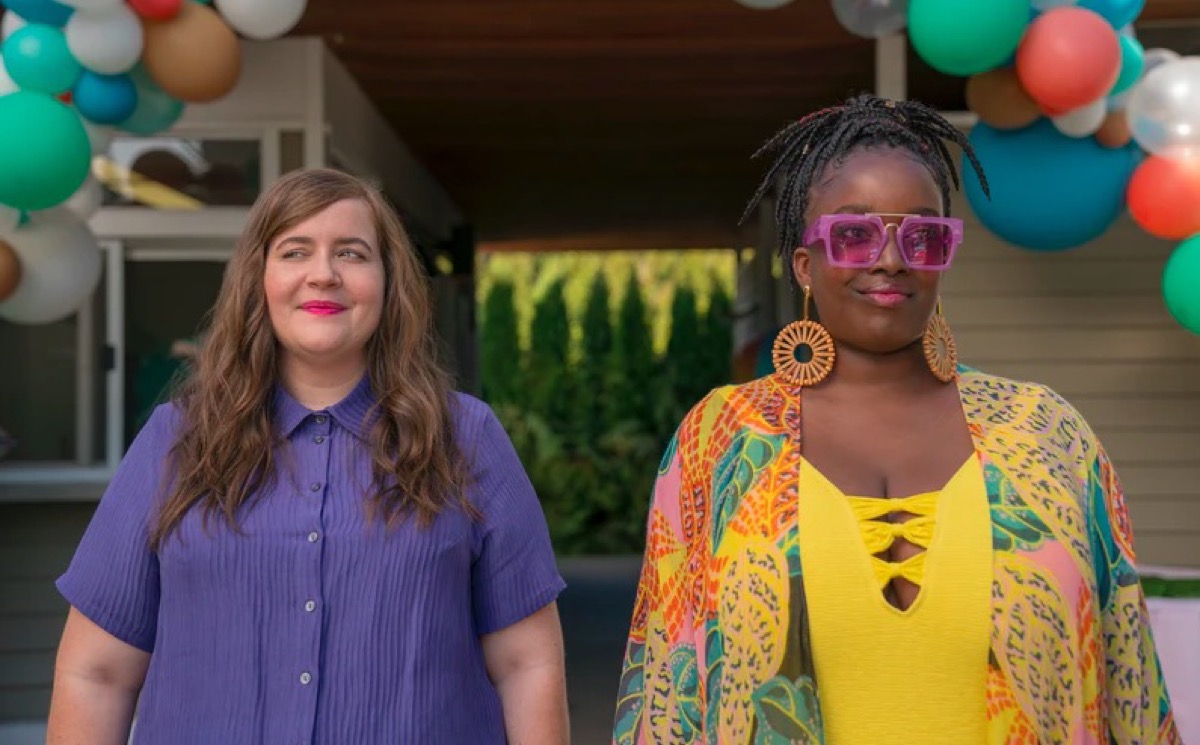Hulu’s Shrill Season 3 Isn’t Perfect, but It Feels Like a Sendoff

For two seasons, Hulu’s Shrill—based loosely on Lindy West’s memoir of the same name—has presented nuanced commentary on the reality of existing as a fat person in a wildly fatphobic society. On May 7, the series will debut its third and final season, and once again, it tackles some deeply uncomfortable topics while simultaneously giving viewers plenty to love.
Shrill season three features Aidy Bryant’s Annie dealing with the aftermath of her breakup with Ryan (Luka Jones) and her growing reputation as the “you go fat queen” writer at The Thorn, a fictionalized version of Portland’s The Stranger (where West worked for years). Meanwhile, her best friend and roommate, Fran (Lolly Adefope), navigates a new relationship with Em (E.R. Fightmaster), and Amadi (Ian Owens) attempts to control Gabe’s (John Cameron Mitchell) worst instincts as The Thorn’s managing editor. This season wraps a few dangling storylines from previous seasons, while also sending beloved characters on new adventures and introducing new faces, including Cameron Britton (Mindhunter, The Umbrella Academy).
In their late 20s, Annie and Fran are both struggling to hit certain adult milestones, particularly when it comes to relationships. Shrill season three takes the time to dive into their past together and focus on how their friendship has shaped their present, which includes their romantic relationships and their approach to work. This is perhaps the most compelling arc of the entire series, and it’s good to see the show focus so much on these characters in the final season.
To some extent, season three feels like a proper sendoff, though it seems that the writers and producers had plans for more, because certain threads—including a few major ones—are left dangling. This is likely because Shrill season three was filmed in fall 2020 (with COVID-19 measures in place), but Hulu canceled the show in January of this year.
Shrill has always excelled at centering fat characters who are complex and complicated, and it mostly continues to do so in its final eight episodes. That said, Shrill season three also attempts to tackle actual current events in Annie’s fictional Portland, and the results aren’t great. Although the show is based on a memoir and there are clear parallels between its world and ours, Shrill bites off a bit more than it can chew in season three by briefly attempting to comment on white nationalist separatist groups and the Black Lives Matter movement.
It’s a marked tonal shift for the series as a whole, which ultimately fails when the white characters who platform white supremacy are woobified by the writing. Black characters are given minimal space to react onscreen, and white characters’ feelings are centered throughout the storyline, which further adds to the problematic nature. After Adefope’s Fran was given so much space to grow in season two, this is a particularly jarring and frustrating slide backwards to season one, when Fran and Amadi were relegated mostly to the background while Annie cavorted around Portland making messes she couldn’t clean up.
Shrill season three is far from perfect. Annie and Fran have some stunning moments with their romantic partners and with each other, and there is some decent character growth. However, this season feels much more scattered than its predecessors, and there’s less cohesion in how information is presented and processed. The season may have benefitted from one or two additional episodes, but more so, it would have benefitted from continuing relationships that were established in the first two seasons and not creating plots that would ultimately vilify characters the audience has been rooting for since day one.
In so many ways, Shrill is a triumph for fat representation on TV. It makes a solid argument for why fat people deserve to tell our own stories, and why we need to be present both in front of and behind the camera to make that happen. It strays a bit in its final season, which is unfortunate, but hopefully, Hulu has set a precedent for more series like this to be greenlit and do even better in the future.
(image: Hulu)
Want more stories like this? Become a subscriber and support the site!
—The Mary Sue has a strict comment policy that forbids, but is not limited to, personal insults toward anyone, hate speech, and trolling.—
Have a tip we should know? tips@themarysue.com